The Dead Zone
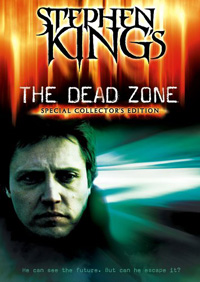 David Cronenberg. Stephen King. Christopher Walken. You need no other excuse to check out this movie other than the fact that it’s the one and only time that those three names shared credit space at the opening of a film; and at a time when they were all creatively at the top of their game as director, writer and actor respectively. The Dead Zone is based on King’s successful novel of the same name, adapted for the screen by Jeffrey Boam (with a polish by David Cronenberg) and stars Christopher Walken at a time just before he became the "go-to" eccentric character actor in just about everything.
David Cronenberg. Stephen King. Christopher Walken. You need no other excuse to check out this movie other than the fact that it’s the one and only time that those three names shared credit space at the opening of a film; and at a time when they were all creatively at the top of their game as director, writer and actor respectively. The Dead Zone is based on King’s successful novel of the same name, adapted for the screen by Jeffrey Boam (with a polish by David Cronenberg) and stars Christopher Walken at a time just before he became the "go-to" eccentric character actor in just about everything.
Walken plays Johnny Smith, a content school teacher who has a passion for his job, the admiration of his students and is engaged to the love of his life. But one fateful night, he’s involved in a terrible car accident that puts him in a coma. When he awakens, six years have passed, his limbs have suffered from atrophy, his job is gone and his fiance is now married to another man and a mother to a child that isn’t his. But he’s also awoken from his deep slumber with an unlikely gift; the gift of second sight. One mere touch and he’s able to not only see your past and present, but also see your future.
Behind The Mask: The Rise Of Leslie Vernon
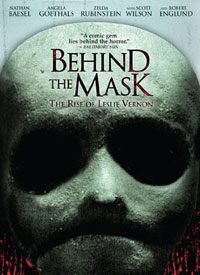 If you ever sought to find a modern day horror film that both celebrated and homaged the great "slasher" era of the '80s, while simultaneously adding something new, fresh and unique to that particular sub-genre, then you need look no further than Behind The Mask: The Rise Of Leslie Vernon.
If you ever sought to find a modern day horror film that both celebrated and homaged the great "slasher" era of the '80s, while simultaneously adding something new, fresh and unique to that particular sub-genre, then you need look no further than Behind The Mask: The Rise Of Leslie Vernon.
In the world of the film, our modern day real life boogeymen don’t exist. There’s no Charles Manson or John Wayne Gacy or Jeffrey Dahmer. But the cinematic baddies that we’re all well versed in – Freddy Krueger, Jason Voorhees, Michael Myers – all exist in the world of Behind The Mask. They are in fact folklore. Camp fire tales. Legends. The next great killer to join their ranks, whose name will evoke terror and fear to the small, little town of Glen Echo, will be Leslie Vernon. To document both his training and first onslaught, Vernon (Nathan Baesel) has invited a small crew of college filmmakers, fronted by aspiring journalist Taylor Gentry (Angela Goethels), to join him as he becomes the sure-to-be-legendary masked maniac. The results are both frightening and hilarious.
Child's Play
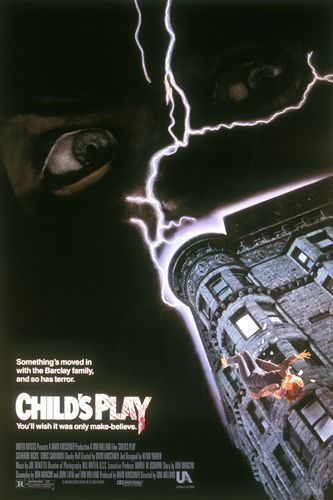 Taking a cue from the infamous Twilight Zone episode “Talking Tina,” as well as the Zuni doll segment from Trilogy Of Terror, director (and writer) Tom Holland was not only able to craft a “killer doll” movie rich with mythology that is both suspenseful & terrifying, but also arguably the best of this particular sub-genre in horror. And Child’s Play wastes no time as it opens in the middle of a police pursuit with Detective Mike Norris (Chris Sarandon) hot on the trail of Charles Lee Ray (Brad Douriff), the notorious serial killer known as the Lakeshore Strangler who has just been ditched & abandoned mid-robbery by his accomplice Eddie Caputo (Neil Giuntoli). The chase ends in a local toy store where, after a brief gun fight, Ray is mortally wounded. But before he dies, he performs a voodoo ceremony to transfer his soul into that of a Good Guy talking doll. Does the mumbo-jumbo spell actually work?
Taking a cue from the infamous Twilight Zone episode “Talking Tina,” as well as the Zuni doll segment from Trilogy Of Terror, director (and writer) Tom Holland was not only able to craft a “killer doll” movie rich with mythology that is both suspenseful & terrifying, but also arguably the best of this particular sub-genre in horror. And Child’s Play wastes no time as it opens in the middle of a police pursuit with Detective Mike Norris (Chris Sarandon) hot on the trail of Charles Lee Ray (Brad Douriff), the notorious serial killer known as the Lakeshore Strangler who has just been ditched & abandoned mid-robbery by his accomplice Eddie Caputo (Neil Giuntoli). The chase ends in a local toy store where, after a brief gun fight, Ray is mortally wounded. But before he dies, he performs a voodoo ceremony to transfer his soul into that of a Good Guy talking doll. Does the mumbo-jumbo spell actually work?
Karen Barkley (Catherine Hicks) is a recently single mother who wants nothing more than to provide for her 6-year-old son Andy. And Andy wants nothing more than to get a Good Guy doll for his birthday. When a peddler out behind the store where Karen works offers to sell her a Good Guy doll for $30 bucks over the normally excessive $100 dollar retail charge, she takes advantage so she can give her son the gift she knows he so desperately wants. All seems fine at first and Andy now has a “best friend to the end”. But then, bad things start happening around Andy.
Intruder

Could you imagine what it would be like to finish an exhausting shift at a retail job, only to find upon closing that there is a killer who wants to use the abundance of box cutters and deli knives to expose your innards? Well, that's where this slasher movie begins, and that is just the beginning of its craftiness. Slasher films are usually really good about having slaughter come in the most inopportune times: swimming, camping, love making, eating and so forth. I think this adds that special tension that comes along with horror films—the old “don't go up the stairs” warning you try to tell the characters by squirming in your seat. Intruder lacks this tension at first because you're not exactly sure what's going on, and with the large cast and lack of character background with any of them, it's hard to decipher where everyone is and who is still alive. Perhaps that's a good thing. Surely when the movie's awesome kill scenes surface, you really don't care who gets the ax; you just want to see how many horrible ways someone could be murdered within an hour at a supermarket.
As mentioned before, the cast is considerably large for a slasher, and they are killed rather swiftly. I couldn't really catch most of the characters' names or tell Ted and Sam Raimi apart, but it really doesn't matter. Jennifer (Elizabeth Cox) and her coworker Linda (Renée Estevez) are the only two employees at the registers when it comes time to close at their supermarket. Meanwhile, all the male workers are busy cleaning, butchering meat, and adding numbers in various parts of the store. The last customer to be rung up is Jennifer 's ex-boyfriend who was recently released from prison. Their breakup has left him a little disgruntled, and he picks a fight with her. When the fight turns physical, all the male workers attack and kick the brute out. The police are called and can't find him, so everyone goes about their routine closing, which seems to take much longer than it normally should. They all get together and one of the veterans there expresses his disappointment that the store will be closing and the property handed over to the government. A little more prep work is done for the following day, but when it comes time for everyone to leave, no one is able to make it out of the front door. Using meat hooks in the cooler, table saws, box cutters and various knives, a mysterious killer has infiltrated the store and intends on leaving no one standing. But is Jennifer's woman-beating boyfriend the culprit or does someone else have a score to settle?
Continue ReadingPsycho II
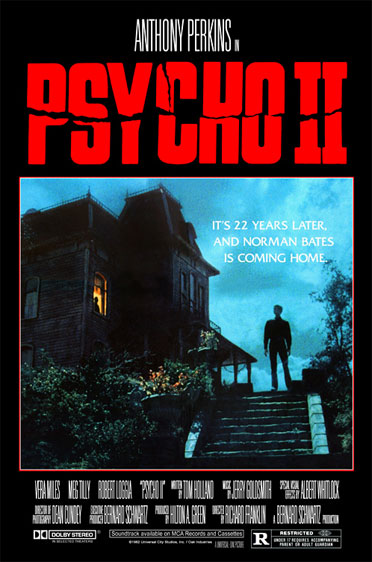 Imagine this daunting task—you’re a young on-the-rise Australian filmmaker & devoted Hitchcock protégé with a handful of successful low-budget thrillers under your belt and you’re eagerly waiting a big break in Hollywood. You’re paired up with an actor-turned-screenwriter who only had a few modestly successful horror films on his resume. And then you’re asked to make a sequel to one of the most influential films of all time from a director you spent your entire life idolizing. That’s the position Richard Franklin was put in when he was asked to helm Psycho II for Universal Pictures in 1982 and, thankfully, he rose to the challenge and met it with full confidence, successfully re-introducing Norman Bates to a whole new generation of film lovers.
Imagine this daunting task—you’re a young on-the-rise Australian filmmaker & devoted Hitchcock protégé with a handful of successful low-budget thrillers under your belt and you’re eagerly waiting a big break in Hollywood. You’re paired up with an actor-turned-screenwriter who only had a few modestly successful horror films on his resume. And then you’re asked to make a sequel to one of the most influential films of all time from a director you spent your entire life idolizing. That’s the position Richard Franklin was put in when he was asked to helm Psycho II for Universal Pictures in 1982 and, thankfully, he rose to the challenge and met it with full confidence, successfully re-introducing Norman Bates to a whole new generation of film lovers.
Ignoring the radical and bizarre direction that Robert Bloch’s sequel book took, writer Tom Holland (who at the time had penned Class of 1984, The Beast Within, and The Initiation Of Sarah) opted instead to tell a brand new story, picking up 22 years after the events of the first Psycho film. The film had ended with Norman Bates being arrested after a string of murders at the Bates Motel which he committed as his alternate personality, his crazed, wild-eyed mother. Psycho II actually opens with the shower scene since this moment from the original and the character of Marion Crane (Janet Leigh) play so heavily into the plot of the sequel. After a brief credit montage, we’re in the court room where Norman Bates is declared to be restored to sanity and is officially set free, much to the dismay of Lila Loomis aka Lila Crane, Marion’s sister, once again reprised by actress Vera Miles. Despite her protests and her signed petition, Norman walks out of the courthouse a free man, is escorted by his doctor, Bill Raymond (Robert Loggia) back to his house and his motel, and is set up with a job at the local diner.
Creepshow 2
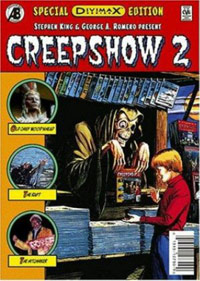 Most genre fans seem to cite the original Creepshow as the definitive and best horror anthology film ever made, but I’ve always had more of a soft spot and appreciation for its sequel Creepshow 2. The first Creepshow was the brainchild of famed horror author Stephen King (Carrie, Christine, Cujo, The Shining, It, The Dead Zone) and legendary horror director George A. Romero, the creator of Night Of The Living Dead and in essence the father of the movie version of the modern “zombie.” Their idea was to put together a live action anthology film which collected five unique horrific tales ala the old EC comics of the 1950s which featured Tales From The Crypt, The Vault Of Horror and The Haunt Of Fear. (Side-note: EC comics were also the creators of MAD magazine!) The segments drew in an all star cast including names such as Ed Harris, Leslie Nielson, Adrienne Barbeau and even King himself. While considered a sleeper hit at the box office upon its release, it would take five years before the sequel came to fruition.
Most genre fans seem to cite the original Creepshow as the definitive and best horror anthology film ever made, but I’ve always had more of a soft spot and appreciation for its sequel Creepshow 2. The first Creepshow was the brainchild of famed horror author Stephen King (Carrie, Christine, Cujo, The Shining, It, The Dead Zone) and legendary horror director George A. Romero, the creator of Night Of The Living Dead and in essence the father of the movie version of the modern “zombie.” Their idea was to put together a live action anthology film which collected five unique horrific tales ala the old EC comics of the 1950s which featured Tales From The Crypt, The Vault Of Horror and The Haunt Of Fear. (Side-note: EC comics were also the creators of MAD magazine!) The segments drew in an all star cast including names such as Ed Harris, Leslie Nielson, Adrienne Barbeau and even King himself. While considered a sleeper hit at the box office upon its release, it would take five years before the sequel came to fruition.
For Creepshow 2, King provided the stories and Romero penned the script, but this time he vacated the director’s chair for Michael Gornick, Romero’s long-time cinematographer. Also, whereas the first film featured five separate segments and clocked in at 120 minutes, the sequel keeps a lean pace of three stories (plus an animated wrap around) all within 90 minutes. Famed FX artist Tom Savini (also a long-time Romero collaborator) portrays the live action version of “The Creep” during the prologue segment. Without further ado, here’s a break down of the three fiendish tales!
The Stepfather (1987)

The whole "death to remakes" wave didn’t really hit me until there was a remake of this film. It seems as though when one produces a remake of a movie that was very popular or influential to a genre, such as The Thing or Clash of the Titians, audiences will keep in mind the differences and critical aspects of both, often remaining loyal to the original or the "better" of them. At the very least, every generation is aware of the fact that it was a remake. With The Stepfather, it seems as though no one really remembers the first, which is a shame. Along with Arachnophobia, it remains one of the few films, horror or otherwise, which can get under my skin in a good way. I’ll admit that I am not a horror buff, which I’d argue is very common for people born after the mid-'80s. Horror films seemed to stand out, if not dominate audiences back then, as they should following a baby boom that left a considerable amount of teenagers and young adults who expected the ultimate theater experience. Many of the films that I’ve just been introduced to are some of the most well designed films around, in any genre. Not just for story, but for the lack of computer effects and some notorious soundtracks by awesome conductors.
The Stepfather plants its tactics in the home, unlike most other horror films. There are no (fictional) monsters—no radiated zombies or blood thirst beasts. The film opens with its most psychologically disturbing scene. A peaceful suburb is overlooked and all the attention is placed on a beautiful home. A man washes his bloody hands in a bathroom. He looks like a gangly lumberjack. Within minutes, he is showered and begins to change his appearance right down to his eye color. Standing in the mirror now is a clean-shaven gentleman in a nice suit. The look on his face both before and after his transformation tells us that there is a screw loose up there in his big head. He puts his old clothes, spectacles, and wedding ring into a suitcase and walks into the hall, where the buzz of a phone off the hook has spread throughout the house. He returns some toys to their bin (he's a tidy man, after all). You see adorable photos off-kilter on the stairway and still you are not alarmed, until he reaches the bottom of the steps and blood is smeared on the wall. The mangled bodies of his wife and young daughter are on the floor; it becomes obvious that he is the killer. But what does he do before he leaves the grizzly scene? Places the blood-smeared phone back in its cradle and puts the cushion of a chair back where it belongs. It’s as if he’s thinking that when the cops find the massacre, they will note that barbarians didn’t live there.
Continue ReadingThe Hunchback of Notre Dame

A true ‘must-see’ of silent cinematic majesty, Hunchback stars the unbelievably talented Lon Chaney, an innovator of pantomime and makeup artistry. The film is based on the Victor Hugo novel about Quasimodo, the hunchbacked bellringer who falls in love with Esmeralda, a gypsy girl.
It is a classic story that is further accentuated by enormous sets, complex lighting and Chaney’s amazing ability to express suffering, humiliation,and desire for the understanding of a kindred soul. It should be noted that Chaney’s great skill at displaying identifiable human emotions under grotesque disguises can be partly attributed to the need to communicate with his deaf-mute parents. His body language and gestures are the center of this movie. He demonstrated his prowess at making us FEEL the character’s emotions in film after film until his death in 1930 after his final appearance in his only sound film The Unholy Three,a remake of an earlier silent film that he starred in. Anybody even remotely interested in the movies before they spoke should see this.
Continue ReadingThe People Under the Stairs

The People Under the Stairs is absolutely bonkers. It's as if David Lynch and Wes Craven took a field trip to the ghetto and came away with an outrageous idea for a thriller/horror movie. Everett McGill and Wendy Robie of Twin Peaks take on another strange domestic role as a brother and sister who never seemed to grow out of playing house and who like to steal children. The movie shares the same violent color schemes and unsettling (yet somehow humorous) dialogue that you find in practically every Lynch film.
Following the newly 13-year-old Poindexter “Fool” Williams (Brandon Quintin Adams), the story opens up with a tarot reading from his older sister Ruby that warns of a year filled with death and ignorance. The two siblings are struggling to make ends meet as their mother is slowly dying of cancer. They're the only tenants remaining in a building that their landlord wishes to tear down in order to make room for condos and tenants who aren't predominately black. Ruby's boyfriend Leroy (Ving Rhames) is a petty criminal who's tired of seeing families thrown to the streets and offers Fool an alternative in making the payments they need to stay there. He's come across a map of the landlord's home and plans to rob it. Rumor has spread across generations that the steep rent and poor conditions of the ghetto has led to a ton of profits for the landlord. This money, thought to be a mass hoard of gold coins, is said to be inside and Leroy wants to get his hands on it.
Continue ReadingFrontiere(s)
-web.jpg)
For a country not known for redefining or even perpetuating the horror genre, the French are starting to step up to the plate and show the world how it’s done. In recent years, we’ve seen several little horrifying gems come from a place better known for idiosyncratic comedies, dark fairytales and, essentially, the definition of modern cinematic storytelling. Such films include Irreversible, Haute Tension, Inside, and this film – Frontiere(s).
First of all, I have to thank Phil Blankenship for motivating me to check this one out. I had read a really good review in a recent issue of Fangoria yet I wasn’t convinced. Apparently, it was apart of the “8 Films To Die For” festival that takes place in November (that could very well be the reason I didn’t take this one too seriously upon discovery). It wasn’t until my conversation with Phil that I really took notice.
Continue Reading




